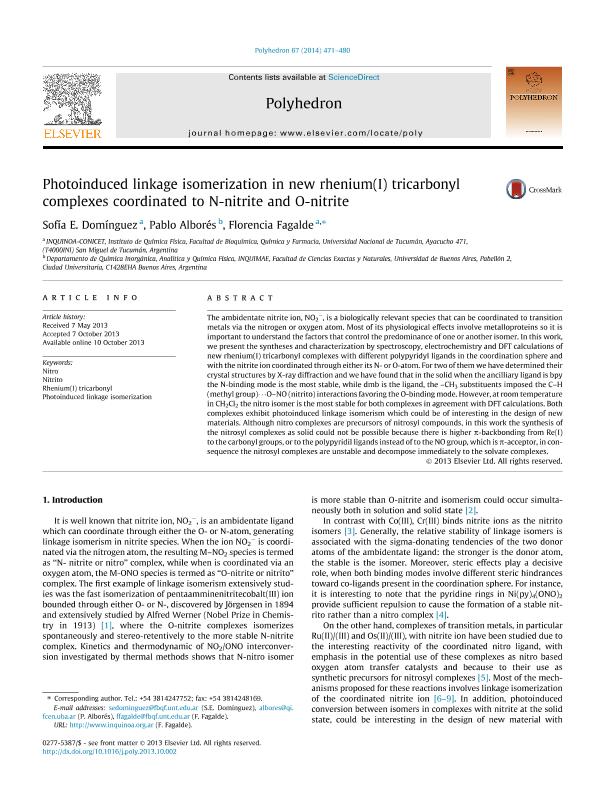Artículo
Photoinduced linkage isomerization in new rhenium(I) tricarbonyl complexes coordinated to N-nitrite and O-nitrite
Fecha de publicación:
10/2013
Editorial:
Elsevier
Revista:
Polyhedron
ISSN:
0277-5387
Idioma:
Inglés
Tipo de recurso:
Artículo publicado
Clasificación temática:
Resumen
The ambidentate nitrite ion, NO2−, is a biologically relevant species that can be coordinated to transition metals via the nitrogen or oxygen atom. Most of its physiological effects involve metalloproteins so it is important to understand the factors that control the predominance of one or another isomer. In this work, we present the syntheses and characterization by spectroscopy, electrochemistry and DFT calculations of new rhenium(I) tricarbonyl complexes with different polypyridyl ligands in the coordination sphere and with the nitrite ion coordinated through either its N- or O-atom. For two of them we have determined their crystal structures by X-ray diffraction and we have found that in the solid when the ancilliary ligand is bpy the N-binding mode is the most stable, while dmb is the ligand, the –CH3 substituents imposed the C–H (methyl group)⋯O–NO (nitrito) interactions favoring the O-binding mode. However, at room temperature in CH2Cl2 the nitro isomer is the most stable for both complexes in agreement with DFT calculations. Both complexes exhibit photoinduced linkage isomerism which could be of interesting in the design of new materials. Although nitro complexes are precursors of nitrosyl compounds, in this work the synthesis of the nitrosyl complexes as solid could not be possible because there is higher π-backbonding from Re(I) to the carbonyl groups, or to the polypyridil ligands instead of to the NO group, which is π-acceptor, in consequence the nitrosyl complexes are unstable and decompose immediately to the solvate complexes.
Palabras clave:
Nitro
,
Nitrito
,
Rhenium (I) Tricarbonyl
,
Photoinduced Linkage Isomerization
Archivos asociados
Licencia
Identificadores
Colecciones
Articulos(INQUINOA)
Articulos de INST.DE QUIMICA DEL NOROESTE
Articulos de INST.DE QUIMICA DEL NOROESTE
Citación
Domínguez, Sofía Eugenia; Alborés, Pablo; Fagalde, Florencia; Photoinduced linkage isomerization in new rhenium(I) tricarbonyl complexes coordinated to N-nitrite and O-nitrite; Elsevier; Polyhedron; 67; 10-2013; 471-480
Compartir
Altmétricas




